1997 PONTIAC BONNEVILLE engine
[x] Cancel search: enginePage 2 of 405
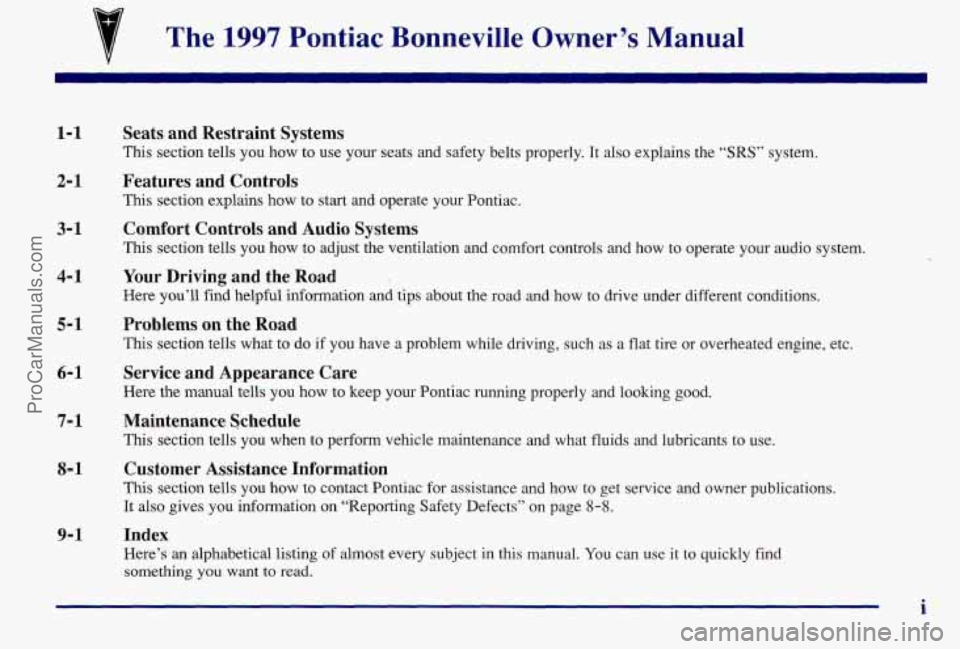
7 The 1997 Pontiac Bonneville Owner’s Manual
1-1
2- 1
3-1
4- 1
5-1
6-1
Seats and Restraint Systems
This section tells you how to use your seats and safety belts properly. It also explains the “SRS’’ system.
Features and Controls
This section explains how to start and operate your Pontiac.
Comfort Controls and Audio Systems
This section tells you how to adjust the ventilation and comfort controls and how to operate your audio system.
Your Driving and the Road
Here you’ll find helpful information and tips about the road and how to drive under different conditions.
Problems on the Road
This section tells what to do if you have a problem while driving, such as a flat tire or overheated engine, etc.
Service and Appearance Care
Here the manual tells you how to keep your Pontiac running properly and looking good.
7-1 Maintenance Schedule
This section tells you when to perform vehicle maintenance and what fluids and lubricants to use.
8- 1
9-1
Customer Assistance Information
This section tells you how to contact Pontiac for assistance and how to get service and owner publications.
It also gives you information on “Reporting Safety Defects” on page
8-8.
Index
Here’s an alphabetical listing of almost every subject in this manual. You can use it to quickly find
something you want to read.
i
ProCarManuals.com
Page 6 of 405

L
Vehicle Symbols
These are some of the symbols you may find on your vehicle.
For example,
these symbols
are used on an
original battery:
POSSIBLE A
CAUTION
INJURY
PROTECT EYES BY
SHIELDING
CAUSTIC
ACID COULD BATTERY
CAUSE
BURNS
AVOID
SPARKS
OR
FLAMES
SPARK
OR ,111,
COULD FLAME
EXPLODE BATTERY
These symbols are important
for you and
your passengers
whenever your
vehicle
is
driven:'
DOOR LOCK
UNLOCK
FASTEN SEAT
BELTS
These symbols
have to
do with
your lamps:
SIGNALS e
TURN
FOG LAMPS # 0
These symbols
are on some
of
your controls:
WINDSHIELD
WIPER
WINDSHIELD DEFROSTER
WINDOW
DEFOGGER
VENTILATING
(
FAN
These symbols
are used on
warning and
indicator lights:
COOLANT -
TEMP -
CHARGING I-1
BAllERY
SYSTEM
BRAKE
(a)
COOLANT
a
ENGINE OIL
PRESSURE
-4
ANTI-LOCK (@)
BRAKES
Here are some
other symbols
you may see:
FUSE
t
LIGHTER a
HORN )tr
SPEAKER
b
FUEL p3
V
ProCarManuals.com
Page 54 of 405
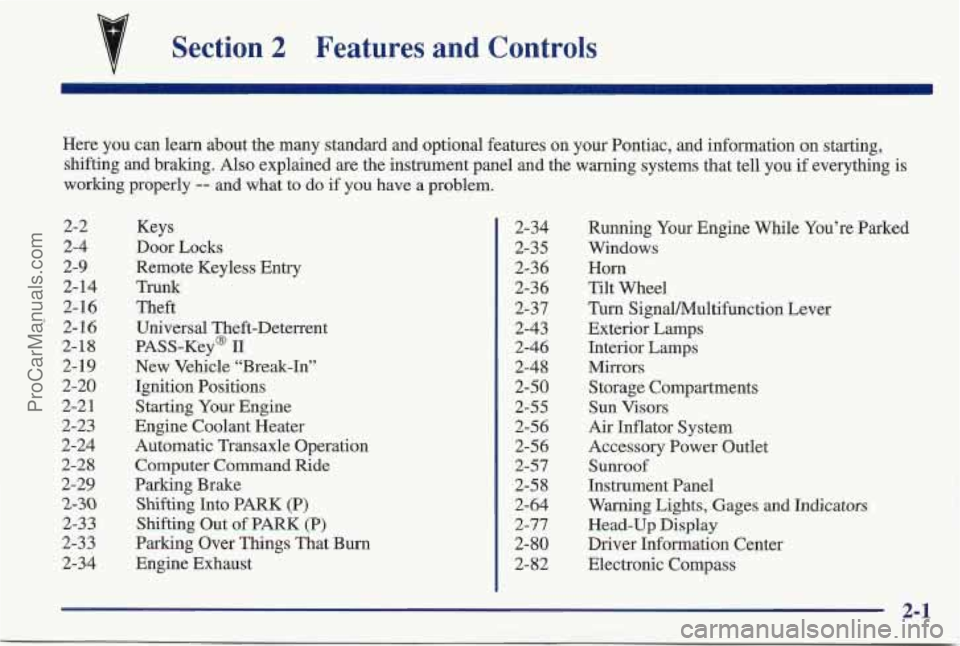
Section 2 Features and Controls
Here you can learn about the many standard and optional features on your Pontiac, and information on starting,
shifting and braking. Also explained are the instrument panel and the warning systems that tell you if everything
is
working properly -- and what to do if you have a problem.
2-2
2-4
2-9
2- 14
2-16
* 2-16
2-18
2-19
2-20
2-2
1
2-23
2-24
2-28
2-29
2-30
2-33
2-33
2-34 Keys
Door Locks
Remote Keyless Entry Trunk
Theft
Universal Theft-Deterrent
PASS-Key@
I1
New Vehicle “Break-In”
Ignition Positions
Starting
Your Engine
Engine Coolant Heater
Automatic Transaxle Operation Computer Command Ride
Parking Brake
Shifting Into PARK (P)
Shifting Out of PARK (P)
Parking Over Things That Bum
Engine Exhaust 2-34
2-3
5
2-3 6
2-36
2-37
1 2-43
~ 2-46
2-48
2-50
2-55
2-56
2-56
2-57
2-5 8
2-64
2-77
2-80
2-82 Running
Your Engine While You’re Parked
Windows
Horn
Tilt Wheel
Turn SignalMultifunction Lever
Exterior Lamps
Interior Lamps
Mirrors
Storage Compartments
Sun Visors
Air Inflator
System
Accessory Power Outlet
Sunroof
Instrument Panel
Warning Lights, Gages
and Indicators
Head-Up Display
Driver Information Center
Electronic Compass
2-.l
ProCarManuals.com
Page 62 of 405
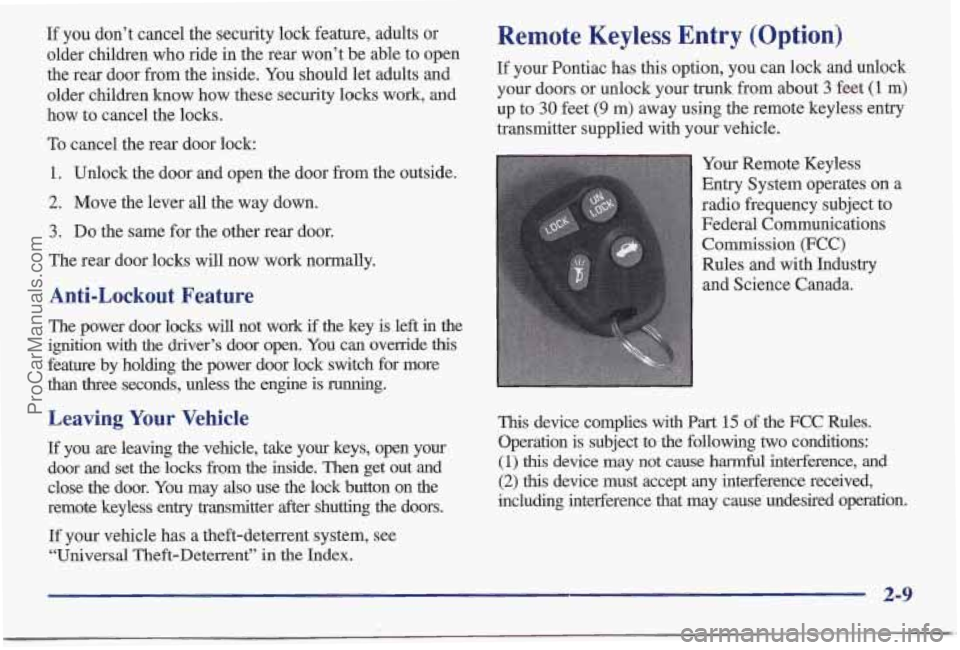
If you don’t cancel the security lock feature, adults or
older children who ride in the rear won’t be able to open
the rear door from the inside. You should let adults and
older children know how these security locks work, and
how
to cancel the locks.
To cancel the rear door lock:
1. Unlock the door and open the door from the outside.
2. Move the lever all the way down.
3. D’o the same for the other rear door.
The rear door locks will now work normally.
Anti-Lockout Feature
The power door locks will not work if the key is left in the
ignition with
the driver’s door open. You can override this
feature by holding the power door lock switch for more than three seconds, unless the engine is running.
Leaving Your Vehicle
If you are leaving the vehicle, take your keys, open your
door and set
the locks from the inside. Then get out and
close the door. You may also use the lock button on the
remote keyless entry transmitter after shutting the doors.
If your vehicle
has a theft-deterrent system, see
“Universal Theft-Deterrent” in the Index.
Remote Keyless Entry (Option)
If your Pontiac has this option, you can lock and unlock
your doors or unlock your trunk from about
3 feet (1 m)
up to 30 feet (9 m) away using the remote keyless entry
transmitter supplied with your vehicle.
Your Remote Keyless
Entry System operates
on a
radio frequency subject to
Federal Communications Commission
(FCC)
Rules and with Industry
and Science Canada.
This device complies with Part 15 of the FCC Rules.
Operation is subject to the following
two conditions:
(1) this device may not cause harmful interference, and
(2) this device must accept any interference received,
including interference that may cause undesired operation.
2-9
ProCarManuals.com
Page 68 of 405

Remote Trunk Release Lockout (Option)
The trunk release lockout valet switch in the trunk
allows you to secure items
in the trunk. By pressing the
left side
of the valet switch, the remote trunk release
button below the driver’s door armrest will be disabled.
Push the right side
of the valet switch to enable the
remote trunk release button to work again.
Trunk Security Override (Option)
Pressing the trunk symbol on the remote transmitter
opens the trunk even if the remote
trunk release lockout
switch is activated.
Trunk Lid
It can be dangerous to drive with the trunk lid
open because carbon monoxide (CO) gas can
come into your vehicle.
You can’t see or smell
CO. It can cause unconsciousness and even death.
If you must drive with the trunk lid open or if
electrical wiring or other cable connections must
pass through the seal between the body and the
trunk lid:
Make sure all windows are shut.
”urn the fan on your heating or cooling
system to its highest speed with the setting
on
ECON or VENT. That will force outside
air into your vehicle. See “Comfort
Controls” in the Index.
If you have air outlets on or under the
instrument panel, open them all the way.
See “Engine Exhaust’’ in the Index.
ProCarManuals.com
Page 71 of 405

PASS-K~~~ 11
Your vehicle is equipped
with the PASS-Key
11
(Person’alized Automotive
Security System)
theft-deterrent system.
PASS-Key
11 is a passive
theft-deterrent system. It
works when
you insert
or remove the key from
the ignition.
PASS-Key
I1 uses a resistor pellet in the ignition key
that matches a decoder
in your vehicle.
When the PASS-Key
I1 system senses that someone is
using
the wrong key, it shuts down the vehicle’s starter
and fuel systems. For about thee minutes, the starter
won’t work and fuel won’t go to the engine.
If someone
tries to start your vehicle again or uses another key
during this time, the vehicle will not start. This
discourages someone
from randomly trying different
keys with different resistor pellets in
an attempt to
make a match. The
ignition key must be clean and
dry before it’s
inserted in the ignition or the engine may not start.
If the
engine does not start and the SECURITY light is
on, the
key may be dirty or wet.
Turn the ignition off.
Clean and dry the key. Wait about three minutes and try
again. If the starter s’till won’t work, and the key appears
to be clean and dry, wait about three minutes
and try
another ignition key. At this time, you may also want to
check the fuse (see “Fuses and Circuit Breakers” in the
Index);
If the staster won’t work with the other key, your
vehicle needs service.
If your vehicle does start, the first
ignition key may be faulty. See
your Pontiac dealer or a
locksmith who can service the PASS-Key 11.
If you accidentally use a key that has a damaged or
missing resistor pellet, the starter won’t work, and the
SECURITY light will flash. But you don’t have to wait
three minutes before trying another ignition key.
2-18
ProCarManuals.com
Page 72 of 405
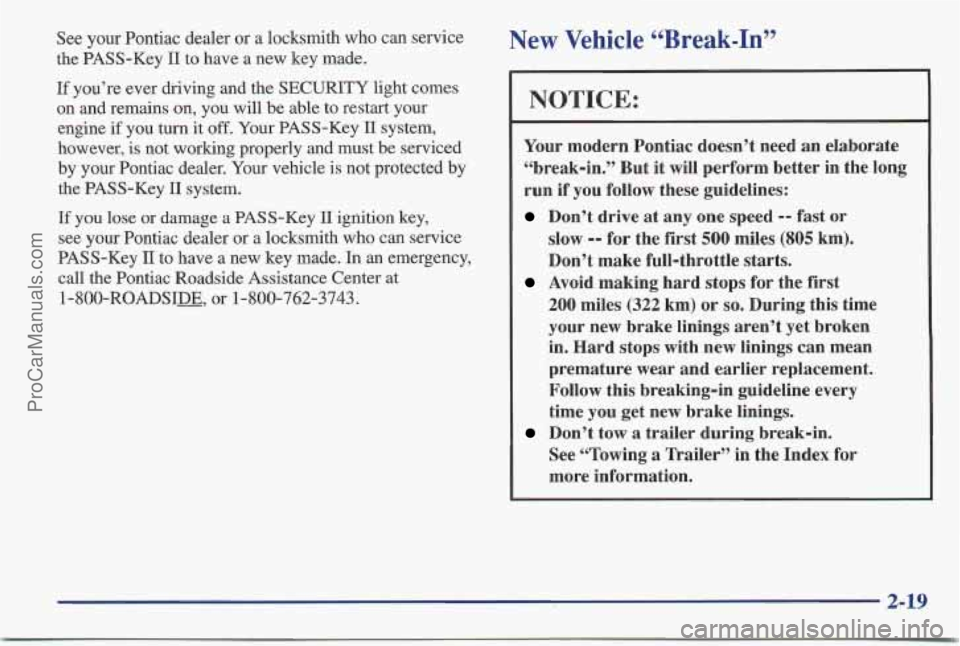
See your Pontiac dealer or a locksmith who can service
the PASS-Key
I1 to have a new key made.
If you’re ever driving and the SECURITY light comes
on and remains on, you will
be able to restart your
engine
if you turn it off. Your PASS-Key I1 system,
however,
is not working properly and must be serviced
by your Pontiac dealer. Your vehicle is not protected by
the PASS-Key
I1 system.
If you lose or damage a PASS-Key I1 ignition key,
see your Pontiac dealer or a locksmith
who can service
PASS-Key
I1 to have a new key made. In an emergency,
call the Pontiac Roadside Assistance Center
at
l-SOO-ROADSI~, or 1-800-762-3743.
New Vehicle CCBreak-In”
NOTICE:
Your modern Pontiac doesn’t need an elaborate
“break-in.” But it will perform better in the long
run if you follow these guidelines:
Don’t drive at any one speed -- fast or
slow
-- for the first 500 miles (805 km).
Don’t make full-throttle starts.
200 miles (322 km) or so. During this time
your new brake linings aren’t yet broken
in. Hard stops with new linings can mean
premature wear and earlier replacement.
Follow
this breaking-in guideline every
time you get new brake linings.
See “Towing
a Trailer” in the Index for
more information.
Avoid making hard stops for the first
Don’t tow a trailer during break-in.
2-19
ProCarManuals.com
Page 73 of 405
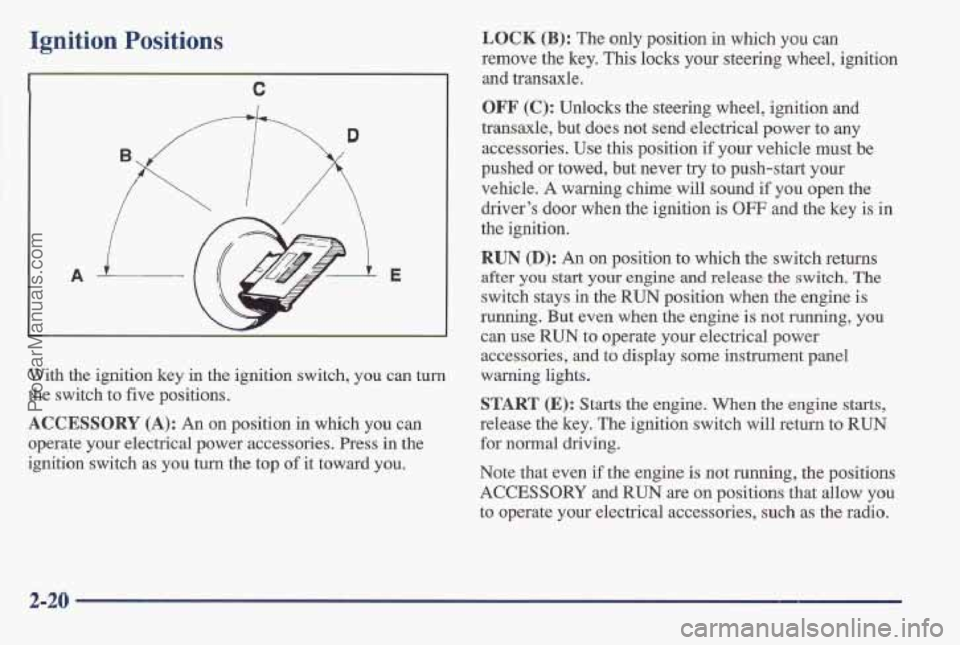
Ignition Positions
C
A E
With the ignition key in the ignition switch, you can turn
the switch to five positions.
ACCESSORY (A): An on position in which you can
operate your electrical power accessories. Press in the
ignition switch as you
turn the top of it toward you.
LOCK (B): The only position in which you can
remove the key. This locks your steering wheel, ignition
and transaxle.
OFF (C): Unlocks the steering wheel, ignition and
transaxle, but does not send electrical power to any
accessories. Use this position if your vehicle must be
pushed
or towed, but never try to push-start your
vehicle.
A warning chime will sound if you open the
driver’s door when the ignition
is OFF and the key is in
the ignition.
RUN (D): An on position to which the switch returns
after you start your engine and release the switch. The
switch stays in the RUN position when the engine is
running. But even when the engine is not running, you
can use RUN
to operate your electrical power
accessories, and
to display some instrument panel
warning lights.
START (E): Starts the engine. When the engine starts,
release the key. The ignition switch will return to RUN
for normal driving.
Note that even
if the engine is not running, the positions
ACCESSORY and RUN are on positions that allow
you
to operate your electrical accessories, such as the radio.
2-20
ProCarManuals.com